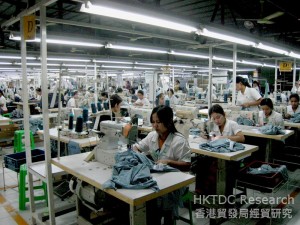Archives
Business, Freight News, Logistics
Myanmar Rising: Opportunities in Asia’s Final Production Frontier
[ June 20, 2016 // Gary G Burrows ]Smooth government transition in April 2016 affirms a continuation of Myanmar’s reform policy, boding well for its manufacturing sector.
With soaring wages and difficulty in recruiting workers, many manufacturers in China’s Pearl River Delta region (PRD) are exploring ways to minimize their production cost, including relocation or diversification of their labor-intensive production activities to areas where labor cost is lower, while retaining complicated, high-value production processes in their PRD factories.
In searching for an alternative production base, Southeast Asia tops the list with an abundant supply of workers at competitive wages. Myanmar, the largest country in mainland Southeast Asia by geographical area with rich natural resources and a youthful population, has gained greater attention from many investors in the past years thanks to the implementation of a series of economic and political reforms by the military-backed civilian government since 2011.
Because political stability is always ranked high as a factor in identifying or short listing locations for relocating production bases, HKTDC Research recently undertook a field trip to Myanmar, setting out to assess the suitability of the country as an alternative production base in the lead up to the formation of a new government in April 2016.
A Strategic Shift from Agriculture to Industry
Just 15 years ago, nearly 60% of Myanmar’s GDP came from the primary sector and the economy relied heavily on the exports of natural resources and agricultural products. With an aim to speed up economic transition from agriculture to industry and services, the Myanmar government under ex-President Thein Sein adopted export- and FDI-led development strategies by creating a positive business environment for investors. This was achieved, among other things, through the enactment of a new investment law in 2012, development of SEZs and more industrial zones.
As a result, the economic contribution of the industry sector to Myanmar’s economy rose substantially from 26.5% in 2010 to 34.4% in 2014, while the share of agriculture shrank from 36.8% to 27.9% in the same period. Notably, industry overtook agriculture in terms of GDP contribution, and would probably eclipse services over the medium-term. During the period of 2010-2014, Myanmar’s services sector made only a marginal increase to 37.7%.
Reflecting the government emphasis on building up the industry sector to aid GDP growth and create more jobs, investment flows are showing signs of shifting from energy and mining into manufacturing and services.
In 2015, Myanmar’s cumulative FDI jumped by more than 10% from 2014 to US$59.2billion, with US$6.25billion invested in manufacturing, accounting for 10.6% of the total. As of end-December 2015, there were 1,033 FDI enterprises, with 585 going into manufacturing. Among different manufacturing sectors, garment is seen as a key growth engine.
Tags: Myanmar










